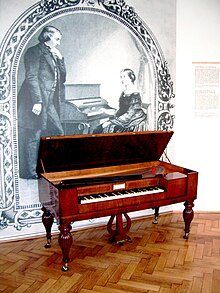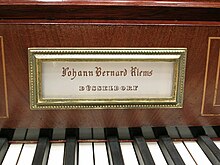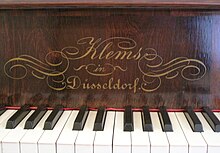Johann Bernhard Klems
Johann Bernhard Klems (born November 19, 1812 in Waltrop , † September 24, 1872 in Düsseldorf ) was a German piano maker of the 19th century.
biography
Born in Waltrop, Johann Bernhard Klems came to Vienna in 1836 to complete his apprenticeship and journeyman time with Streicher , one of the most important piano makers at the time . In 1840 he opened his own piano workshop in Düsseldorf. There he first manufactured instruments that were based on the Viennese piano making tradition ( Viennese mechanics ). A little later he took over major innovations from the then leading French instrument maker Erard . After a short time he was able to gain an excellent reputation as a piano maker. Just ten years after founding his workshop in Düsseldorf, Klems instruments were extremely valued in music circles. Not least because of his skillful business policy, he was able to secure a high level of awareness for his company through the placement of famous composers and pianists at home and abroad. After his death, his son Edmund took over the company. The importance and productivity of the Klems company underlines the fact that in 1880 at least 40 workers made around 300 instruments. Nevertheless, piano and grand piano production was stopped at the turn of the century.
Contacts with important musicians of the 19th century
Klems is often mentioned, particularly in connection with Robert Schumann . In the autumn of 1850 the composer came to Düsseldorf to take up his new position as municipal music director. A close connection between the Schumann couple and Johann Bernhard Klems can be proven from the winter of 1850. Through numerous mentions and comments in the diaries, letters and notes of the Schumanns, Klems' name continues to this day. How much Robert Schumann valued his instruments is shown by the fact that in 1853 he gave his wife a Klems concert grand for her birthday. In 1866, Clara Schumann had a new grand piano delivered to her domicile, which has since been relocated to Baden-Baden . Clara Schumann, the most famous pianist of her time, was rarely satisfied with the pianos made available to her. For many years she preferred the instruments of the Düsseldorf piano maker for her concerts and made numerous recommendations for them to friends, acquaintances and students (she “wouldn't recommend any other German instruments”, as she wrote to a friend). The same can often be learned from reviews of their concerts.
In addition to his connection to Robert and Clara Schumann, Johann Bernhard Klems had other contacts with influential musicians of his time. With Johannes Brahms , who lived in Düsseldorf for a few years from 1854, he was on friendly terms with him throughout his life. Other important composers who made music on Klems instruments were Felix Mendelssohn Bartholdy , Ferdinand Hiller , Theodor Kirchner and Max Bruch .
Awards, experiments and titles
Klems' reputation as one of the most important piano makers of the 19th century is based in particular on his openness to innovations in instrument technology. At the 1st London Industrial Exhibition (the first world exhibition ) in 1851, he showed a grand piano "based on the Erard design " in the Crystal Palace , making him one of the avant-garde German piano makers. As one of the first German piano manufacturers, he adopted the principle of the double repetition mechanism , which was later adopted by all colleagues . Thereupon he opened an agency for his instruments in London in the same year .
At the home exhibition in Düsseldorf he received a “first state award”. And he was also successful at the Munich industrial exhibition in 1854: “Because of the production of an excellently executed wing-shaped piano of the same, good tone”, he was awarded a medal of honor there. With their comment, the Munich jurors did indeed name an essential sound ideal from Klems. In complete contrast to the register sound of grand pianos, which was favored up to the first third of the 19th century (in which high, middle and low registers have their own character similar to the human voice), Klems achieved a previously unattained balance with his new grand pianos " of the same tone ”. With this, however, the instrument also lost its color in favor of a more voluminous sound.
Johann Bernhard Klems' pronounced love of experimentation is also evident in the fact that he and a violin maker from Aachen tried to transfer the technical characteristics of the violin to piano making . In particular, Klems made attempts to transfer the sound properties of the violin varnish of Italian master violins to the soundboards of his grand pianos. This resulted in the so-called resonator wing. “It is powerful in tone, capable of every more delicate nuance, and in particular develops a load-bearing force, a vibration of the individual tones, which ensures the most beautiful effects for the pianist who knows how to use them. (...) ".
He tried in vain to have his research results recognized by the Prussian Patent Office . Important piano manufacturers such as Ibach and Bechstein followed these developments carefully and critically.
After all, the importance of Johann Bernhard Klems is also reflected in a large number of titles. He was able to decorate his instruments with official ratings such as court pianoforte manufacturer to His Royal Highness the Prince Frederick of Prussia , court pianoforte manufacturer to his royal highness Prince Carl Anton zu Hohenzollern-Sigmaringen or court supplier to the ex-king of Hanover , what assured his company an enormous gain in prestige.
Instruments
Some Klems concert grand pianos, pianinos and table pianos have survived to our day. They are present in public institutions ( Heinrich Heine Institute in Düsseldorf or Palais Royal in Brussels) as well as in German, Dutch and Belgian private collections. Especially in connection with the rediscovery of historical performance practice for the music of the Romantic era in CD recordings and concerts, the instruments by Johann Bernhard Klems have returned to the focus of the interested public.
The close connection between Johann Bernhard Klems and Robert Schumann makes it clear what influence changes in instrument construction can have on a composer's sound ideas. The piano works from Schumann's later days in Düsseldorf allow such conclusions to be drawn in their novel orientation and prove how much the musical inspiration of a composer can be shaped by the instrument.
literature
- Robert Schumann diaries, household books ; edited by Georg Eismann and Gerd Nauhaus. Leipzig 1971/82/87
- Tobias Koch : Ensuring the most beautiful effects - keyboard instruments by Johann Bernhard Klems . Leipzig 2007
- Florian Speer : Ibach and the others . Wuppertal 2002
- Michael Struck: The controversial late instrumental works by Schumann . Hamburg 1984
- Renate Hofmann: Clara Schumann's letters to Theodor Kirchner . Tutzing 1996
See also
Web links
- GENUIN Musikproduktion Leipzig - sound recordings from Klems instruments
- Collection of photographs of Klems instruments
- Keyboard wiki - information on historical piano construction, Klems article
- Clara Schumann's favorite instrument - press release of the state capital Düsseldorf from March 19, 2010 (pdf; 63 kB)
Individual evidence
- ↑ Wilhelm Heyer's Museum of Music History in Cöln; Catalog from Georg Kinsky (curator of the museum) - first volume. Stringed keyboard instruments. - Cöln 1910, commissioned by Breitkopf and Härtel, printed by JPBachem in Cöln
- ↑ “(...) A concert grand with cross-string construction from the Klems factory in Düsseldorf turned out to be an instrument of excellent timbre and excellent variety. (...) “(excerpt from a review of a concert by Johannes Brahms on a Klems grand piano in May 1871 in Bremen; quoted from: Tobias Koch, Die schön Zeitenicherd ... - Keyboard instruments by Johann Bernhard Klems . Leipzig 2007)
- ^ Renate Hofmann: Clara Schumann's letters to Theodor Kirchner . Tutzing 1996
- ↑ The instrument played was, as indicated, from the Klems factory in Düsseldorf, whose reputation as the best in Germany has long been recognized and confirmed by authorities. Ms. Schumann prefers to play only Klems' grand pianos, and she spares neither expense nor effort to take it to distant places. (...) And rightly so! because these instruments combine with Erard's mechanics with greater abundance and softness of the tone a great lightness of the playing style, which is of immense importance for the lecture both in the concert hall and in the salon. After making the advantages of French and English manufacturing his own, Klems continued to work and research with German diligence and with never-ending striving, and through his own inventions, especially with regard to resonance (sic!), Acquired the ability to achieve greater achievements. And then, thanks to a strong construction and the highest accuracy in the details, his instruments have greater solidity and, in addition, the significant advantage of greater cheapness, such as Erard, Pleyel, Broadwood of the same quality (excerpt from a review of a piano recital that Clara Schumann published in April 1863 a Klems grand piano in Trier; quoted from: Tobias Koch, The most beautiful effects safeguarding ... - Keyboard instruments by Johann Bernhard Klems . Leipzig 2007)
- ^ Extract from a contemporary review in the "Düsseldorfer Zeitung". After: Tobias Koch: Securing the most beautiful effects - keyboard instruments by Johann Bernhard Klems . Leipzig 2007
| personal data | |
|---|---|
| SURNAME | Klems, Johann Bernhard |
| BRIEF DESCRIPTION | German piano maker |
| DATE OF BIRTH | November 19, 1812 |
| PLACE OF BIRTH | Waltrop |
| DATE OF DEATH | September 24, 1872 |
| Place of death | Dusseldorf |




